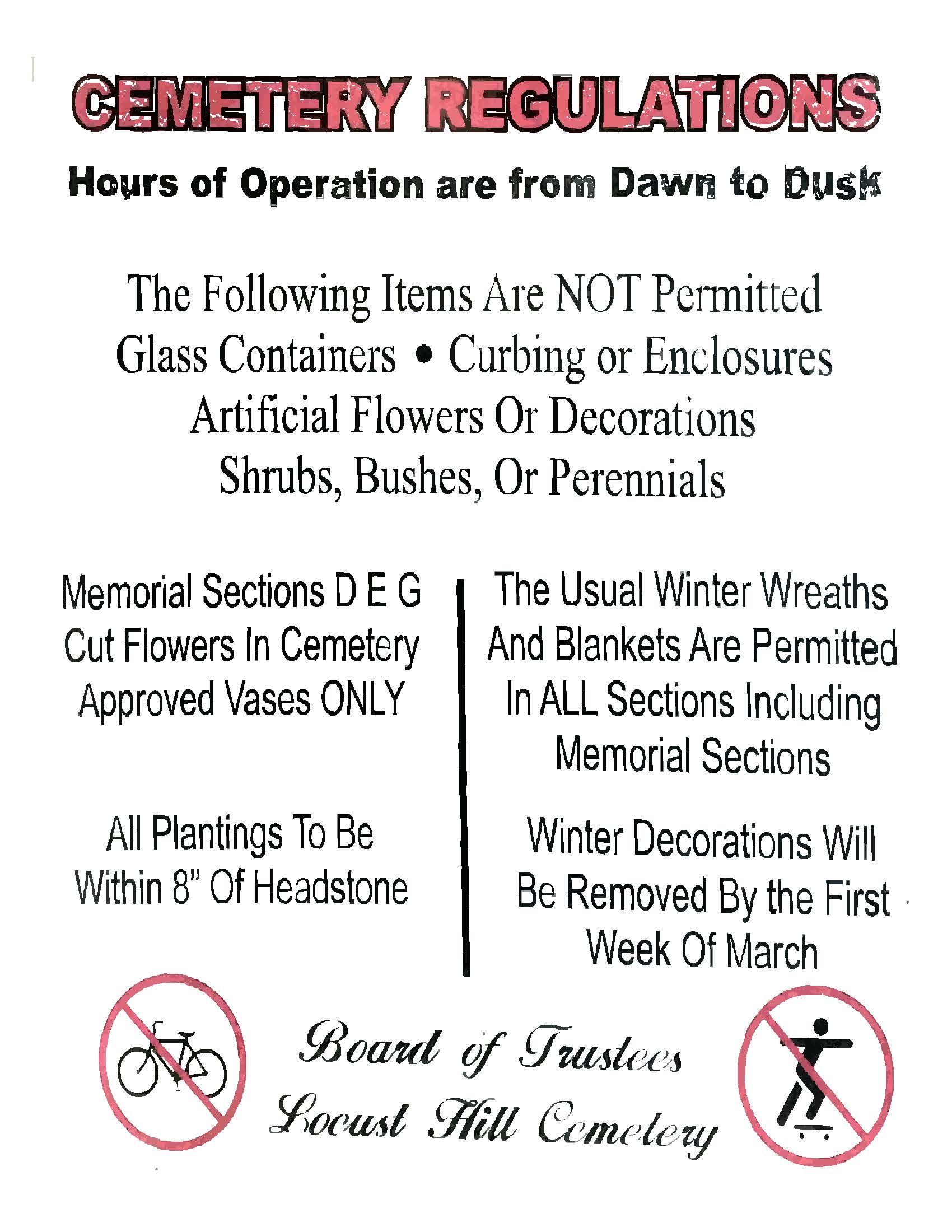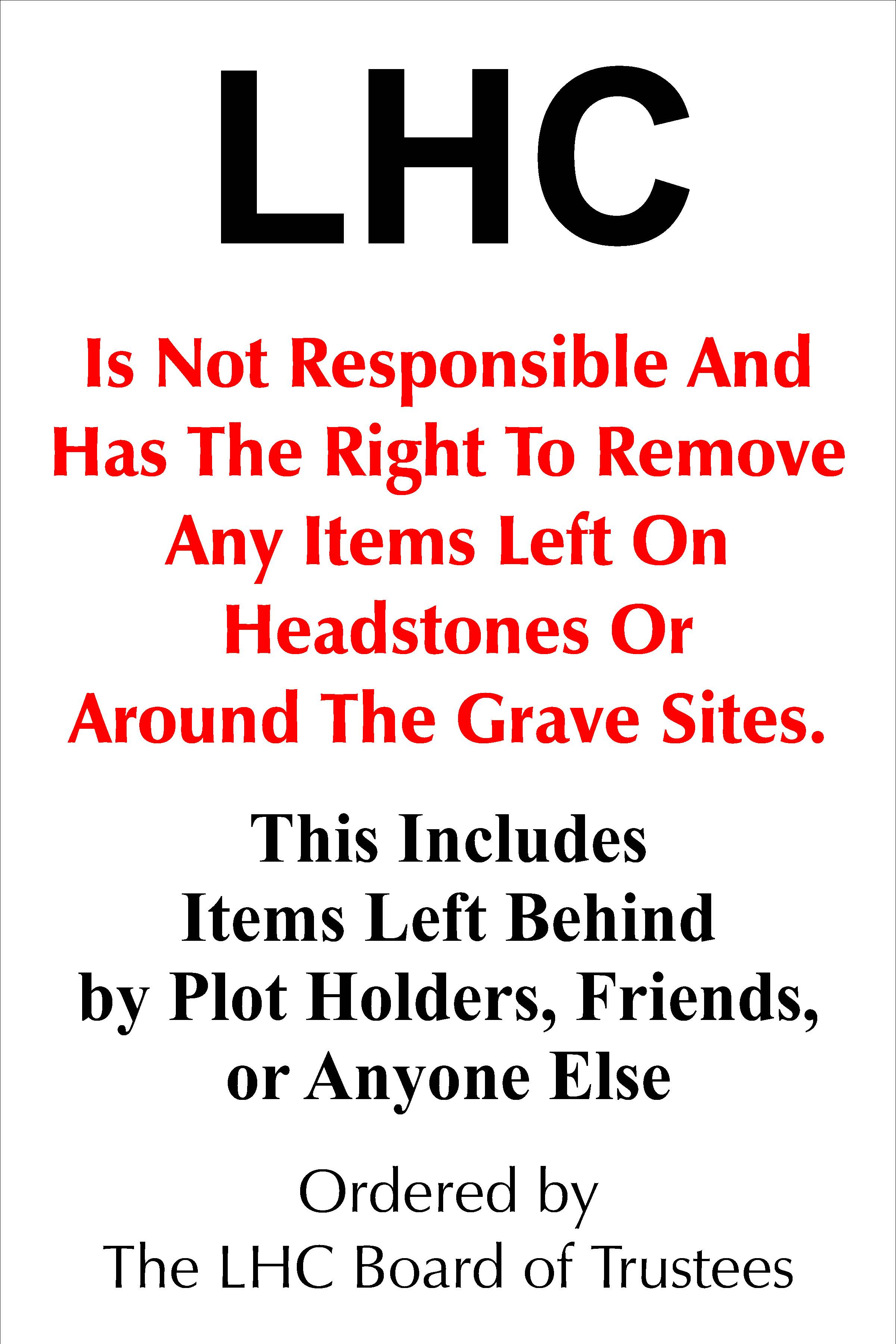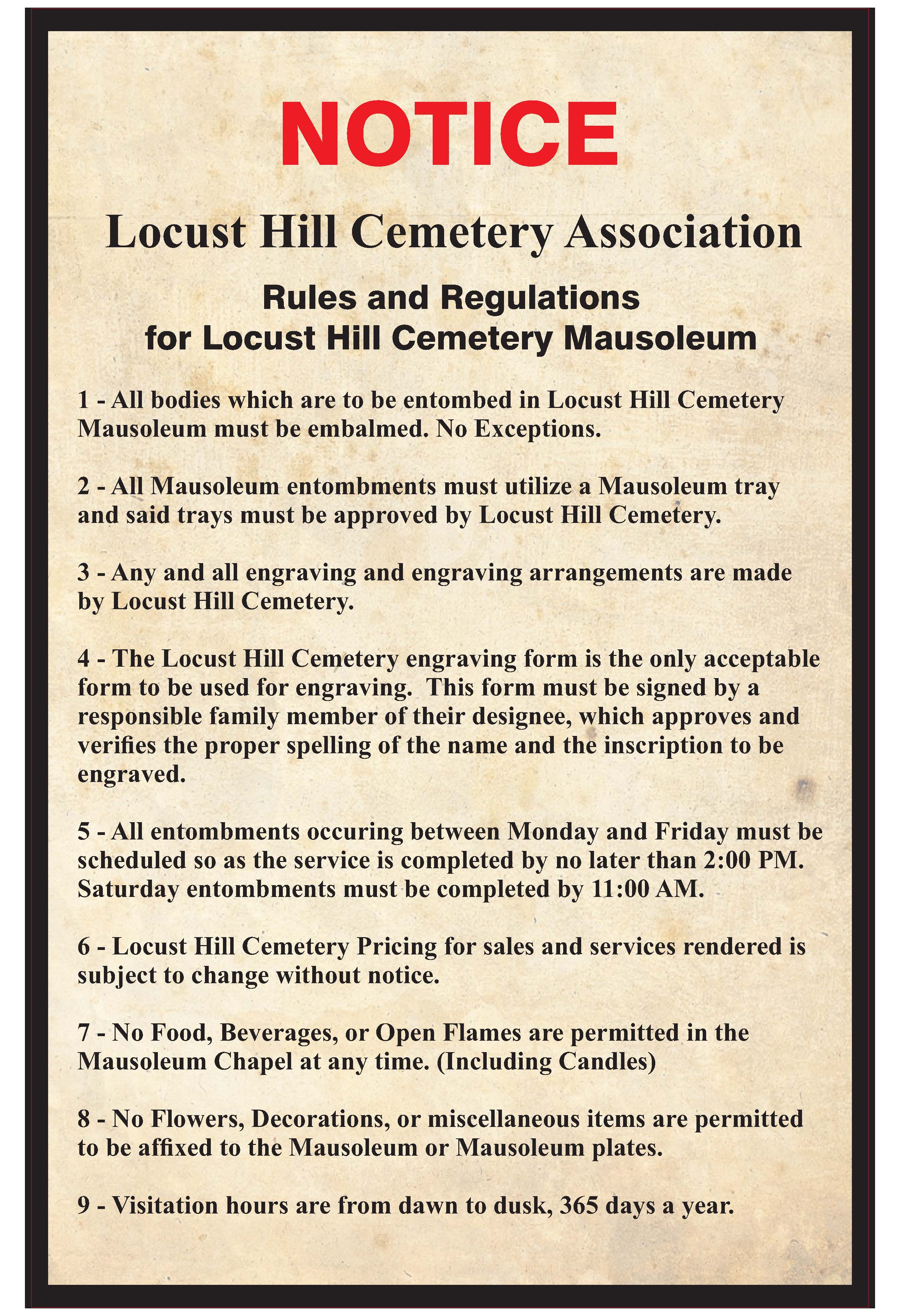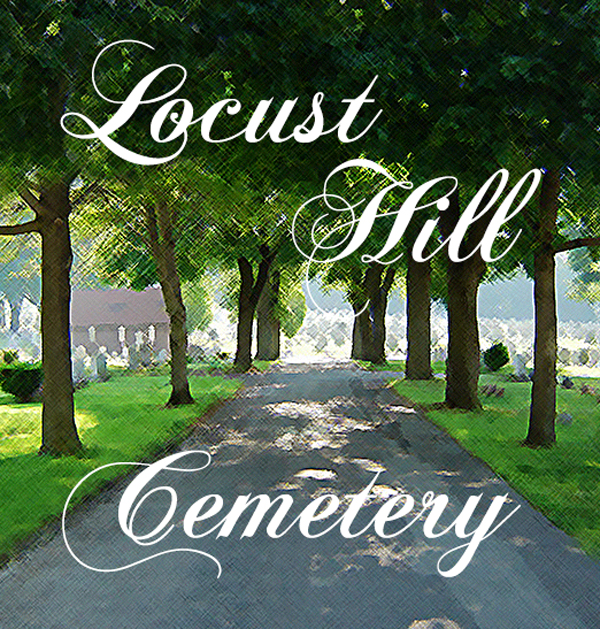
About Locust Hill Cemetery
Contacts
Locust Hill Cemetery168 North Sussex Street
Dover, New Jersey 07801
P: (973)366-0038
Mail: lhcemetery@optonline.net
Office Hours
- Monday-Friday: 7am to 3pm
- Saturday: 7am to 11:30pm
- Sunday: Closed
- Funerals must exit the cemetery by 11:30 am on Saturdays.
Visitors
- Visitors: Cemetery is open 24 hours a day/7 days a week. The gates are never shut, however, we do not advise visiting after dark.
- Cemetery is patrolled by police.

More Information About Mausoleums and Crypts
"Our cemetery offers several different options for families to consider."
Earth Burial
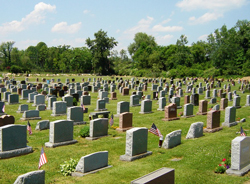 Earth burial is the most common form of disposition at our cemetery. A monument or marker is placed at the head of the grave, which is the most visible sign of the memorialization process. At the Locust Hill Cemetery, we strive to provide the beauty and peacefulness that families deserve.
Earth burial is the most common form of disposition at our cemetery. A monument or marker is placed at the head of the grave, which is the most visible sign of the memorialization process. At the Locust Hill Cemetery, we strive to provide the beauty and peacefulness that families deserve.
Mausoleum Crypt
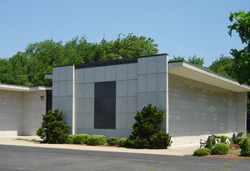 Mausoleums are above ground structures that contain concrete or stone crypts in which the casket is placed. They offer an enduring peace of mind that the sanctity of the deceased is fully protected. A mausoleum crypt offers secure protection that is clean and dry because the burial containers entombed do not come in contact with the earth.
Mausoleums are above ground structures that contain concrete or stone crypts in which the casket is placed. They offer an enduring peace of mind that the sanctity of the deceased is fully protected. A mausoleum crypt offers secure protection that is clean and dry because the burial containers entombed do not come in contact with the earth.
Mausoleum Niche
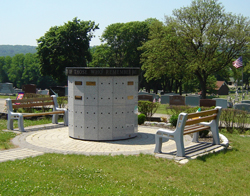 For families choosing cremation, we offer mausoleum niches in our cemetery. A niche is just like a mausoleum crypt, only smaller, designed to hold an urn. It offers the same peace of mind that a mausoleum crypt does.
For families choosing cremation, we offer mausoleum niches in our cemetery. A niche is just like a mausoleum crypt, only smaller, designed to hold an urn. It offers the same peace of mind that a mausoleum crypt does.
Mausoleum Facts
 What is a mausoleum? A community mausoleum is simply a large building designed to provide above-ground interment or entombment for a number of unrelated people. Sharing the cost of the mausoleum with other individuals has made it more affordable. Crypts are designed to hold casketed remains. Following a casket entombment, the crypt is sealed and a granite or marble front is attached. Niches will accommodate urns containing cremated remains. Mausoleum crypts are both clean and dry. They offer a viable alternative for those who simply have an aversion to being interred in the ground. Furthermore, with the growing shortage of available land for cemetery use, mausolea allow for a maximum number of entombments in a minimum amount of space.
What is a mausoleum? A community mausoleum is simply a large building designed to provide above-ground interment or entombment for a number of unrelated people. Sharing the cost of the mausoleum with other individuals has made it more affordable. Crypts are designed to hold casketed remains. Following a casket entombment, the crypt is sealed and a granite or marble front is attached. Niches will accommodate urns containing cremated remains. Mausoleum crypts are both clean and dry. They offer a viable alternative for those who simply have an aversion to being interred in the ground. Furthermore, with the growing shortage of available land for cemetery use, mausolea allow for a maximum number of entombments in a minimum amount of space.Are all mausolea the same? No. There are indoor community mausolea and outdoor or garden community mausolea. There are also family mausolea, which are relatively small, privately owned structures designed to house the remains of individual families.
What are interment rights? When you purchase interment rights you in fact purchase the right to designate who may be entombed or interred in the space, rather than purchasing the crypt/niche/grave or urn space itself, which remains the property - and the responsibility - of the cemetery. Interment rights include the right to place a memorial where permitted, in the case of a crypt or niche an inscription on the crypt or niche front. All interment rights are subject to the Cemetery Rules and Regulations, copies of which are available at the cemetery office.
What is an interment rights holder? An interment rights holder is the person(s) who owns interment rights in a cemetery, mausoleum, or columbarium. The interment rights holder has the right to specify who may be entombed or interred in the crypt/niche/grave or urn space. Written permission from the interment rights holder(s) is required prior to each entombment or interment.
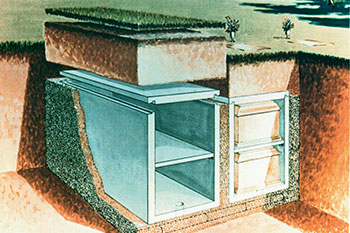 Are there different types of crypts? Yes. Single crypts are designed for one entombment only. There are three kinds of double crypts: tandem crypts permit two entombments lengthwise in a crypt; companion crypts permit two entombments side-by-side; westminster crypts permit two entombments, the first below floor level, and the second above it. Most mausolea are built four, five and sometimes six crypts high. The price of the crypt will depend on its location and type of crypt. For example: upper level crypts are less expensive than those located at eye level.
Are there different types of crypts? Yes. Single crypts are designed for one entombment only. There are three kinds of double crypts: tandem crypts permit two entombments lengthwise in a crypt; companion crypts permit two entombments side-by-side; westminster crypts permit two entombments, the first below floor level, and the second above it. Most mausolea are built four, five and sometimes six crypts high. The price of the crypt will depend on its location and type of crypt. For example: upper level crypts are less expensive than those located at eye level.What types of memorials are permitted? An inscription on the crypt front is the form of memorial most often chosen with entombment. The same is true of niches, although niche fronts are more widely varied and include bronze and glass. A memorial, in some way, celebrates a life which has been lived. It can take many forms. Some people choose memorial scholarships or charitable gifts.
Can an urn containing cremated remains be placed in a crypt? A number of urns containing cremated remains may be placed in a crypt. All that is required is the permission of the interment rights holder(s). The size of the crypt front may limit the number of memorial inscriptions.
What is included in the entombment fee? The entombment fee includes administration and permanent record-keeping (determining ownership, obtaining permission and the completion of other documentation which may be required, entering entombment particulars in the interment register, maintaining all legal files); opening and closing the crypt or niche, and replacing the marble or granite front. Any other supplies and /or services which may be required at the time of an entombment would be at an additional cost.
Does a body have to be embalmed before it may be entombed? No. These days, embalming is largely a matter of choice. However, if you are planning a funeral service which might include several days of visitation with an open casket, embalming is probably advisable. Furthermore, if the body is to be transported any great distance, and particularly outside the state, it may be necessary. Certain states, provinces and countries have very stringent regulations for transporting human remains.
What if I prefer entombment, but my spouse prefers cremation? This need not be a problem. One solution is to purchase a crypt which would allow for the entombment of a casket or container, as well as an urn containing cremated remains. · May more than one person own the interment rights to the same crypt/niche? Yes. Interment rights can be owned by one person, or by more than one person as joint tenants or as tenants-in-common.
What is the difference between the various types of ownership? Sole ownership means one individual, the interment rights holder, owns the interment rights. Upon the death of the interment rights holder, his/her estate retains ownership of the interment rights. Joint Tenants are two or more individuals owning interment rights. Upon the death of the interment rights holder, the surviving interment rights holder(s) retains ownership of the interment rights. Upon the death of the last surviving interment rights holder, his/her estate retains ownership of the interment rights. Tenants-in-Common are two or more individuals owning interment rights. Upon the death of an interment rights holder, his/her estate retains ownership of the interment rights together with the surviving rights holder(s).
May I designate the future use of my crypt or niche now? Certainly. You may allocate for the future use of both the entombment space and the inscription space. Allocations may be changed or cancelled at any time by the current interment rights holder(s).
May I make all arrangements in advance? Yes. All arrangements may be made in advance. By planning ahead, you have the opportunity to consider the many options available to commemorate a life. You can make an informed decision about your funeral and cemetery arrangements and the form of memorial you prefer, in ways which are meaningful to you and your family. You will gain peace of mind, knowing your family and friends will be relieved of the emotional and financial burden often associated with making arrangements when a death occurs. If you pre-arrange your cemetery and funeral services, you benefit by purchasing at today's prices, free from inflationary pressures in the future. Whether you choose to purchase in advance or not, we recommend that you discuss your preferences with your family before you finalize them. Not doing so can cause anxiety if your wishes conflict with what your family or survivors feel is appropriate.
Decisions and choices in selecting your final resting place.
 Determine if you want to be interred with or without cremation.
Determine if you want to be interred with or without cremation.
Choose between an earth burial, mausoleum crypt or niche.
If you choose an earth burial, what type of marker or memorial will you have (flat or upright), how many others will be buried at this site, and what is your budget?
Here are some terms that may help you understand your cemetery environment:
| # | Term | Definition |
|---|---|---|
| 1 | Casket/Coffin | A box or chest for burying human remains. |
| 2 | Cemetery Property | A grave, crypt, or niche. |
| 3 | Cemetery Services | Opening and closing graves, crypts, or niches; setting grave liners and vaults; setting markers; and long-term maintenance of cemetery grounds and facilities. |
| 4 | Columbarium | A structure with niches (small spaces) for placement of cremated remains in urns or other approved containers. It may be outdoors or part of a mausoleum. |
| 5 | Cremation | Exposing human remains and the container holding them to extreme heat and flame and processing the resulting bone fragments to a uniform size and consistency. |
| 6 | Crypt | A space in a mausoleum or other building to hold cremated or whole human remains. |
| 7 | Disposition | The placement of cremated or whole human remains in their final resting place. A Permit for Disposition must be filed with the local registrar before disposition can take place. |
| 8 | Entombment | Burial in a mausoleum. |
| 9 | Grave | A space in the ground in a cemetery for the burial of human remains. |
| 10 | Grave Liner or Outer Container | A concrete cover that fits over a casket in a grave. Some liners cover tops and sides of the casket. Other liners (vaults) completely enclose the casket. Grave liners minimize ground settling. |
| 11 | Graveside Service | A service to commemorate the deceased held at the cemetery prior to burial. |
| 12 | Interment | Burial in the ground, inurnment, or entombment. |
| 13 | Inurnment | The placing of cremated remains in an urn. |
| 14 | Mausoleum | A building in which human remains are buried (entombed). |
| 15 | Niche | A space in a columbarium, mausoleum, or niche wall to hold an urn. |
| 16 | Urn | A container to hold cremated human remains. It can be placed in a columbarium or mausoleum, or it can be buried in the ground. |
| 17 | Vault | A grave liner that completely encloses a casket. |
